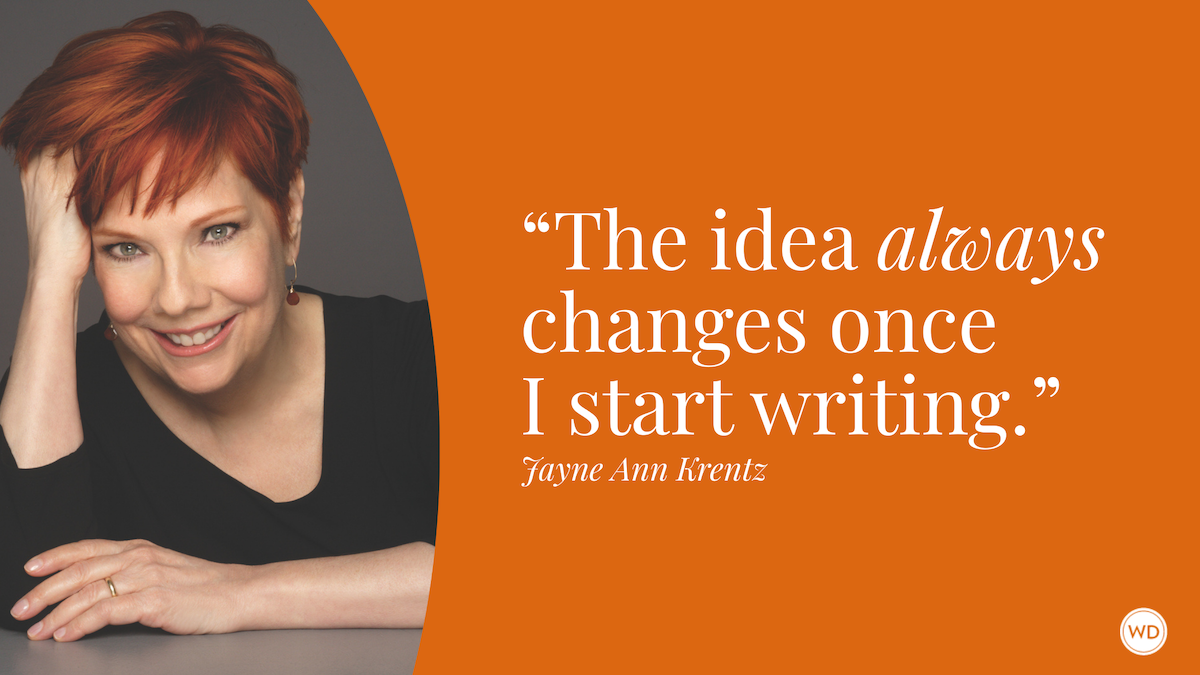Grand Finale: Two Strategies for Writing Great Story Endings
Powerful, unexpected story endings will leave readers hungry for your next novel. Consider the following techniques to help your story resonate long past the last page.
Powerful, unexpected story endings will leave readers hungry for your next novel. Consider the following techniques to help your story resonate long past the last page.
The most gratifying story endings leave readers more than satisfied—they leave them awed.
Which is to say, you need to plan your conclusion just as carefully as every other part of your story. In fact, Joyce Carol Oates once said, “The first sentence can’t be written until the final sentence is written.” Whether her process works for you or you prefer a more organic method, by the end of the story your primary and secondary plotlines have to reach their proper conclusions—with no loose ends dangling. All character and thematic questions must be addressed, all conflicts resolved and any moral quandaries settled.
[Don't miss Jane Cleland's talk at the 2019 Writer's Digest Mystery & Thriller Virtual Conference, April 12-14! Learn more and register.]
Most stories end when the subplots twine around the primary plot to form a seamlessly unified conclusion. Ideally, your ending should be, as Margaret Atwood put it, “completely unexpected and inevitable.” This kind of ending leaves readers enthralled and breathless and clamoring for more. The two approaches discussed in this article can help you achieve this lofty goal: “Unreliable Narrator, Revealed” explains how to optimize the complexity of an unreliable narrator to form a finale bothexciting and thought provoking, while “A Wider Lens” intrigues readers by opening up their perspective from a narrow view to a broader one, as the context shift s and expands. Now, let’s dig deeper into each individual strategy.
UNRELIABLE NARRATOR, REVEALED
Unreliable narrators allow authors great flexibility in determining how to relay information—what to withhold and when to reveal it. Such a device keeps readers guessing, unsure of what’s really going on. If the groundwork is laid properly, readers will be staggered by the shift in perception when the true nature of the unreliable narrator is finally disclosed.
There are five viable types of unreliable narrators. Understanding how the narration in each of these categories works will help you develop a fitting final twist. These types are:
1. THE INNOCENT, UNKNOWING OR MISUNDERSTOOD.
This category includes children, developmentally disabled adults or anyone who comes from one culture and is plunked down in the middle of another.
A child, based simply on their limited experience, lacks the knowledge to fully grasp some of what they see and hear. So, too, might someone with lower-thanaverage intelligence or someone unfamiliar with the environment in which they find themselves. A character might not know some of the vocabulary or cultural references, or they might miss the meaning in nuanced repartee. Another character may understand a word’s denotation but not its connotation, or might report the words but not the intonation, missing cues that identify sarcasm or irony.
Let’s say you’re writing a heist story. You have a character, Daisy, who pays for a cup of coffee with a $100 bill. The cashier asks if she has anything smaller. Daisy pulls out a $5 bill and lays it on top of the $100 bill. “No,” she says in a serious tone. “They’re all the same size.” Daisy’s literal interpretation of the cashier’s question suggests that Daisy misunderstands the question. Won’t readers be surprised when they learn at the end that her apparent mistake is actually a ruse designed to trick a mark into relaxing his vigilance?
2. THE GUILTY.
In this category, we have people who feel at fault and people who are at fault. The narrator may be lying to save face, their marriage, their career, or otherwise protect and preserve whatever they have or think they have. Or the narrator may be an actual criminal.
Sometimes, as in Avi’s 1991 middle-grade novel, Nothing But the Truth: A Documentary Novel, the narrator lies to cover up a weakness or failure. After a teacher gives Philip, the protagonist, a D in one of his classes, he’s not allowed to try out for the track team. Instead of telling his parents the truth, he says he’s not interested in track anymore. The tension between Philip and his teacher escalates when the teacher catches him humming the national anthem instead of singing the words aloud—and she takes it as a personal affront. The ensuing confl ict between freedom of expression and patriotism garners national attention. From the start, readers ask themselves if they can trust Philip’s version of the story, since they know he’s lied to his parents. When the truth is finally revealed—that Philip hummed because he didn’t know the words—we are left with a real Oh, wow moment, and a reminder to never overlook the obvious.
3. THE EMOTIONALLY TAXED OR MENTALLY ILL.
Not all mental illness is equal. Some people suffer mild symptoms; others exist in an alternate universe. Your narrator might be a schizophrenic who believes their hallucinations are real, a new mother suffering from postpartum depression, a war veteran diagnosed with post-traumatic stress disorder or a teen experiencing a hormone-fueled meltdown.
In Dennis Lehane’s 2003 novel, Shutter Island, U.S. Marshal Teddy Daniels visits the Ashecliffe Hospital for the criminally insane on Shutter Island to find an escaped prisoner. By the end of the novel, we discover that Teddy’s reporting is inaccurate. His observations up until this point seem so credible that we’re astonished to learn his version of events have been a confused combination of past occurrences and hallucinations—Teddy is himself a patient at the hospital.
4. THE INCAPACITATED.
A narrator who is an alcoholic on a bender, or a drug addict who drifts in and out of lucidity, is likely to give a skewed account of what they see and do.
The 2015 Paula Hawkins novel, The Girl on the Train, for instance, is told from three points of view: Rachel, Anna and Megan. The story focuses on their experiences with one man, Tom. Since Rachel is an alcoholic who has frequent blackouts, and the other women have reasons to delude themselves or openly lie, all three narrators are suspect. The final twist reveals that the narrator who seemed most unreliable was, in fact, the most accurate.
5. THE PARANORMAL.
Perhaps your narrator is a ghost, the devil, or an extraterrestrial being.
In Clive Barker’s 2007 metafiction novel, Mister B. Gone, narrator Jakabok Botch is a demon trying to exorcise his hate for his abusive father by writing horrific, sadistic short stories. Botch repeatedly tries to get us, the readers, to burn the book in our hands, ultimately revealing that if we’d done so, he would have been freed to kill us. It ends with Botch recommending that the reader give the book to someone they despise. This conclusion, in which we discover Botch’s true motivation, is a fitting and satisfying final reveal.
A WIDER LENS
Employing a wider lens means that the story’s denouement plays out from an unexpected, but logical, alternate view—the kind of dramatic shift in perception that occurs when you leave a tunnel and look back. While deep in a dark tunnel, you only see a pinprick of light far ahead, but once you emerge and look back you realize that the tunnel is only a narrow tube in the wider landscape. Neither perspective is wrong, but opening up that different viewpoint throws the story into broader context.
Take Chuck Hogan’s 2004 thriller, Prince of Thieves. The protagonist, Doug, is a young man who’s certain he’ll end up in prison or die young, as do so many of the men in his life. Then he meets Claire, and for the first time he perceives the possibility of salvation. The story focuses on Doug’s struggle to become worthy of Claire, while resisting his outlaw friends’ efforts to pull him back into a life of crime. Readers think the story ends when Doug is gunned down … but it doesn’t. Just as there are countless inspiring and effective ways to tell a story, there are countless inspiring and effective ways to end it.
Doug manages to drag himself to Claire’s house. He wants to know why she never asked him to stop robbing banks, explaining he would’ve done anything for her. Claire looks at him like he’s crazy. Hogan writes: “And there in her bewilderment, he recognized his grave mistake. … When you give someone the power to save you, you give them the power to destroy you as well.” Until that moment, Doug thought they were a couple, not understanding that to Claire he was just a guy she’d dated a few times. Doug also grasps the deeper meaning —Claire hadn’t failed him; he’d failed himself.
This shift in perspective makes for a gripping, characterbased epiphany. Note that by introducing broader themes, the wider lens approach encourages reflection.
Consider, for example, Rebecca Stead’s 2009 Newbery Medal–winning novel, When You Reach Me. Set in New York City in the 1970s, the story revolves around sixthgrader Miranda and her best friend, Sal. There’s also a subplot about a homeless man in the neighborhood.
Near the end of the book, one of Miranda’s classmates, Marcus, tries to apologize to Sal for beating him up earlier in the week. But Sal, terrified that Marcus is going to attack him again, flees straight into the path of an oncoming truck. The homeless man kicks Sal out of the way, sacrificing his own life to save Sal’s. This heroic act is both horrifying and poignant. The final twist occurs when Miranda learns the homeless man is really an older incarnation of Marcus, who has traveled from the future to save Sal’s life. As Mary Quattlebaum wrote in her Washington Post review: “The story’s structure—an expert interweaving of past, present and future—brilliantly contradicts Miranda’s commonsensical belief that the end can’t happen before the middle.”
By widening the lens with this final twist, we see that the homeless man present throughout the rest of the book not only plays a vital role in saving Sal, but has intended to do so all along, making his subplot tie neatly together with the primary storyline.
THINK IT THROUGH
Whichever approach you take in crafting story endings, take into account these important considerations that will help frame your final pages.
DIFFERENTIATE BETWEEN POINT OF VIEW AND PERSPECTIVE.
Every story requires a point of view and a perspective—and they’re not necessarily the same. POV refers to voice (first person, third person, etc.), while perspective asks whose story is being told.
If you’re using an unreliable narrator, the first-person POV is most effective. If you write from a third-person POV, it’s you, the author, who will be seen as unreliable—not the character.
A good approach to making POV and perspective determinations is to think carefully about whose story you’re telling, then decide who would best narrate that story. In some cases, the narrator may be different from the protagonist. For example, Agatha Christie’s classic Hercule Poirot mystery, The Murder of Roger Ackroyd, is considered a stellar example of an unreliable narrator. Though it’s Poirot’s story, it is Dr. Sheppard who tells us the tale. Nick Carraway is the biased, unreliable narrator of The Great Gatsby, but Gatsby himself is the story’s protagonist.
FORESHADOW WHERE THE STORY IS HEADED.
No matter how the tale ends, you need to plant the seeds in advance. Specifically, you need to weave in clues that, when the time comes, will make an ultimate twist or grand reveal seem natural. One effective technique is to place a telling clue in the middle of a list of like items.
For instance, take Marianne, who’s getting ready to attend her father’s military promotion ceremony. She puts on just a touch of mascara, since he doesn’t like it when she wears too much makeup, replaces her watch with a simple gold bangle, pins back her hair with a matching gold barrette, and smiles into the mirror—determined to be the happy, peppy girl he loves. Ten pages later, we learn Marianne almost missed the ceremony. Ten pages after that, when challenged by her father, Marianne is tearful and apologetic. She explains she lost her watch, feels an inch tall, and begs forgiveness.
Did you catch the clue? Marianne took off her watch—she didn’t lose it. Most readers won’t notice the fib, coming as it does several chapters after the event (and if they do, they might empathize, assuming Marianne lied to protect her father’s feelings). But wait! Why was Marianne late? You didn’t even think about that, did you? That’s the power of foreshadowing— you’ve played fair, and when the truth is ultimately revealed, your readers are surprised and delighted.
…
Both “Unreliable Narrator, Revealed” and “A Wider Lens” are useful tools to finish off your fiction with a wallop. Just as there are countless inspiring and effective ways to tell a story, there are countless inspiring and effective ways to end it. These are two such techniques that, if done well, will allow your themes and character revelations to linger in readers’ minds—and that is the best ending of all.
This article originally appeared in Writer's Digest magazine. Subscribe today to get WD all year long.
Writersdigest.com is a participant in the Amazon Services LLC Associates Program, an affiliate advertising program designed to provide a means for sites to earn advertising fees by advertising and linking to Amazon.com and affiliated websites.
About Jane Cleland
Jane K. Cleland writes both fiction and nonfiction, including the multiple award-winning and long-running Josie Prescott Antiques Mysteries [St. Martin’s & Alfred Hitchcock Mystery Magazine (AHMM)] and the Agatha Award-winning bestsellers Mastering Suspense, Structure & Plotand Mastering Plot Twists [Writer’s Digest Books]. She is a member of the full-time faculty at Lehman College, part of the City University of New York (CUNY), a contributing Editor for Writer’s Digest Magazine, and the chair of the Wolfe Pack’s Black Orchid Novella Award (BONA), in partnership with AHMM. She is a frequent workshop leader and guest author at writing conferences and MFA Residencies, and she produces weekly free podcasts, The Honors Class, a series of one-minute lessons designed to help writers tell captivating stories. Website: janecleland.com. Twitter: @janekcleland









